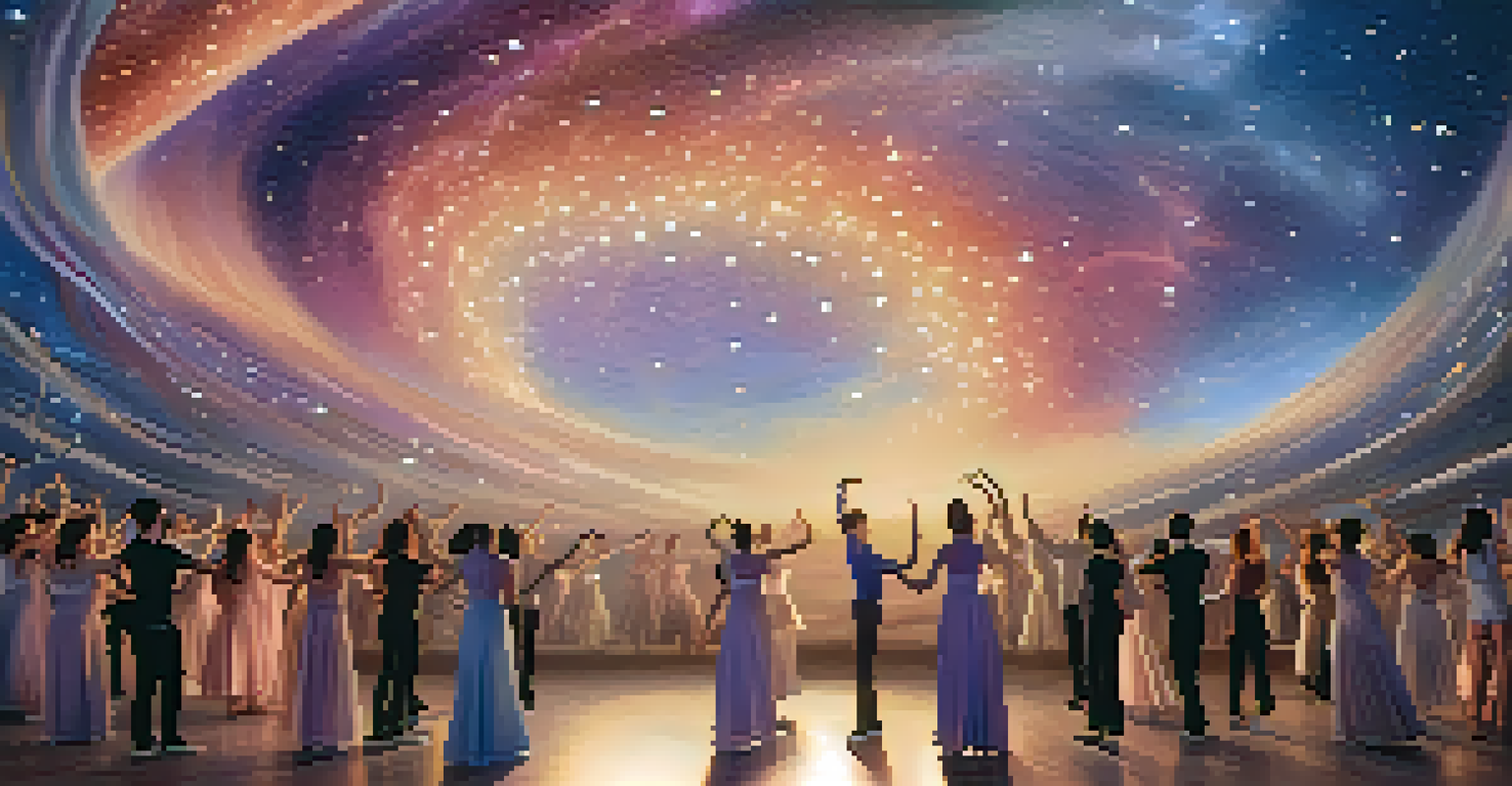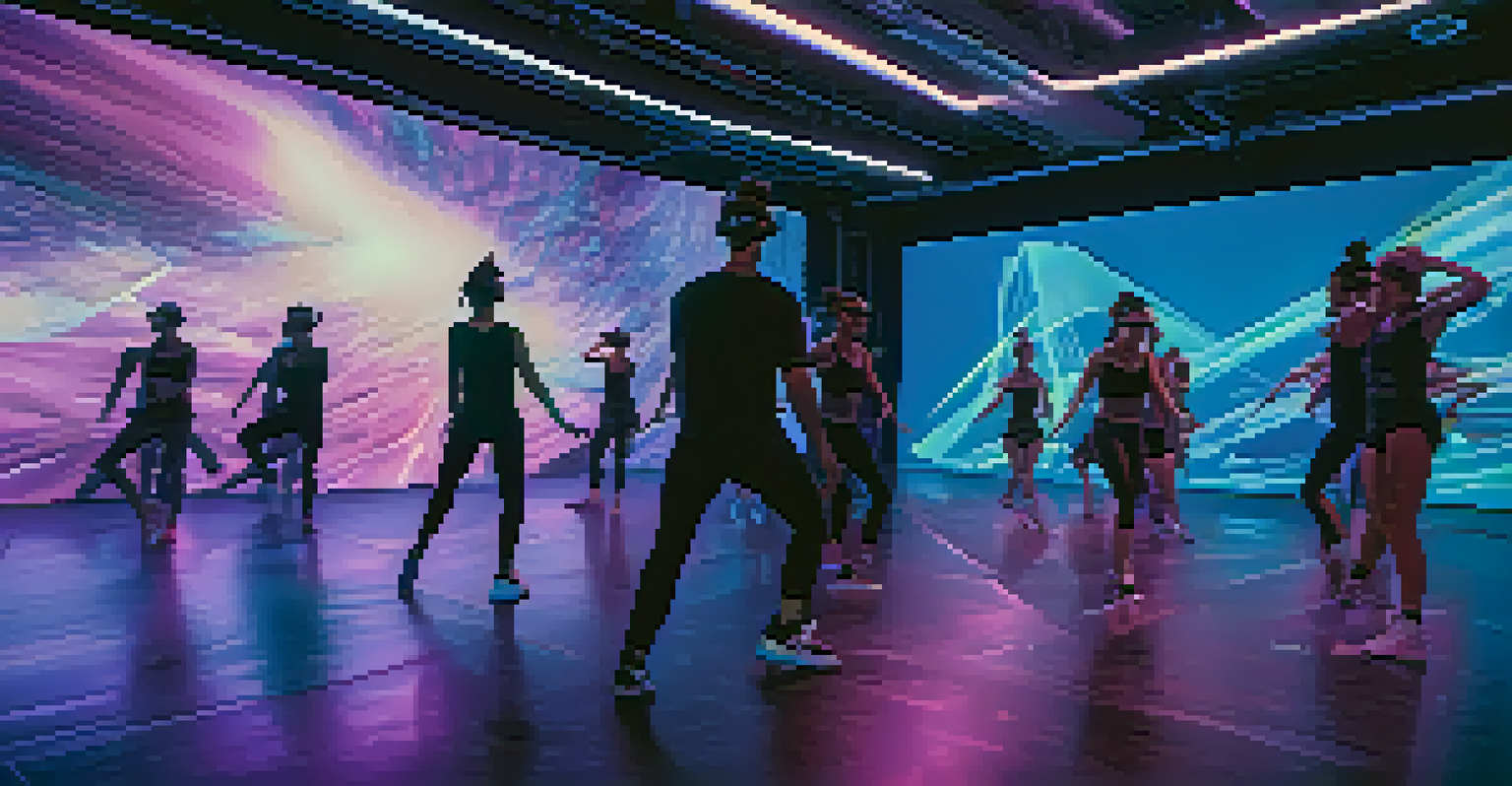Immersive Dance Experiences: Virtual Reality in Choreography

The Rise of Virtual Reality in Dance
In recent years, virtual reality (VR) has emerged as a game-changer in various fields, and dance is no exception. By immersing dancers in a digital environment, VR allows for creative exploration that was previously unimaginable. This technology enables choreographers to visualize movements and spatial relationships in a 3D space, offering a fresh canvas for artistic expression.
Virtual reality is not just a tool; it's a revolutionary force in the world of dance and choreography.
Imagine stepping into a world where your dance studio has no physical boundaries. With VR, dancers can rehearse in virtual spaces that mimic grand theaters or even fantastical landscapes. This not only enhances the rehearsal experience but also encourages collaboration among dancers who may be geographically distant, breaking down barriers of traditional practice.
As the capabilities of VR continue to evolve, so too does the potential for innovative choreography. Dancers can experiment with movements and styles in ways that inspire new ideas, pushing the boundaries of what dance can be. This technological advancement is not just a trend; it's reshaping the very foundation of dance artistry.
Enhancing Choreography Through Immersive Technology
Choreographers are now using VR to create immersive experiences that engage audiences in unprecedented ways. By designing virtual performances, they can manipulate the environment, lighting, and even the soundtrack to enhance the storytelling aspect of dance. This level of control allows for a unique fusion of technology and artistry, captivating viewers like never before.

For example, consider a contemporary dance piece set in a surreal, dreamlike landscape. Through VR, audiences can feel as if they are part of the performance, moving alongside dancers in fantastical settings. This not only elevates the experience but also invites viewers to connect emotionally with the narrative being portrayed.
VR Transforms Dance Choreography
Virtual reality revolutionizes choreography by enabling immersive experiences and innovative movement exploration.
The immersive nature of VR also opens doors to interactive choreography, where audiences can influence the performance through their actions. This creates a dynamic relationship between performer and viewer, transforming traditional roles and fostering a deeper appreciation for the art form.
The Learning Curve: Dancers Adapting to VR
While the integration of VR into dance offers exciting opportunities, it also presents challenges for dancers and choreographers alike. Adapting to this technology requires a willingness to learn and experiment with new tools and techniques. Dancers must develop skills not only in movement but also in navigating virtual environments, which can feel entirely different from physical spaces.
The possibilities are as vast as the imagination, encouraging exploration and experimentation in ways we've never seen before.
Training in VR can initially be disorienting, as dancers must adjust their spatial awareness and body positioning within a digital context. However, with practice, many find that these challenges enhance their overall performance skills, leading to greater versatility and creativity. It's a bit like learning to ride a bike; it may be awkward at first, but soon it becomes second nature.
Moreover, as more dance schools and studios begin to adopt VR training methods, the learning curve will become less steep. This shift in education will prepare the next generation of dancers to thrive in both traditional and virtual environments, expanding their artistic horizons.
Creating Collaborative Choreographies in VR
Collaboration is at the heart of dance, and VR technology makes it easier than ever for artists to work together across distances. Dancers can join virtual studios from anywhere in the world, sharing ideas and choreographic concepts in real-time. This collaborative spirit fosters an exchange of cultural influences, enriching the art form as a whole.
Imagine a choreographer in New York collaborating with dancers in Tokyo, brainstorming movements and refining a piece without ever meeting in person. This global exchange not only broadens the scope of creativity but also allows for the incorporation of diverse styles and techniques, creating a rich tapestry of dance innovation.
Collaboration Across Distances
VR fosters global collaboration among dancers and artists, enriching creative exchanges and cultural influences.
The potential for collaboration extends beyond choreography to include musicians, visual artists, and technologists. By bringing together multifaceted talents in a virtual space, the possibilities for interdisciplinary works expand, ultimately enriching the dance experience for both performers and audiences.
Audience Engagement: Experiencing Dance Differently
One of the most exciting aspects of VR in dance is its ability to change how audiences experience performances. Traditional theater often places viewers in fixed seats, but VR allows for a more interactive engagement, enabling audiences to explore the performance from multiple angles or even participate in the dance. This shift can lead to a more profound emotional connection to the art.
Consider attending a dance performance where you can choose your vantage point, moving around the stage and immersing yourself in the action. This level of engagement can make the viewer feel like an integral part of the performance, rather than just an observer. It transforms the act of watching dance into an experiential journey.
Moreover, VR experiences can be tailored to individual preferences, allowing for personalized interactions with the performance. This customization not only enhances enjoyment but also encourages a broader audience to appreciate the nuances of dance, expanding its reach and impact.
The Future of Dance: Predictions and Possibilities
As we look to the future, the integration of VR into dance is likely to grow even more sophisticated. Innovations in technology will continue to enhance the immersive experience, creating more realistic and engaging environments for both performers and audiences. This evolution may lead to entirely new genres of dance that blend physical movement with digital artistry.
We may also see more cross-disciplinary collaborations, where dance intersects with fields like gaming, film, and virtual art installations. These partnerships could lead to transformative experiences that challenge our understanding of dance and its role in the digital age. The fusion of these elements has the potential to create groundbreaking works that resonate with diverse audiences.
Interactive Audience Engagement
With VR, audiences can engage with performances interactively, enhancing emotional connections and personal experiences.
Ultimately, as both technology and artistry continue to evolve, the landscape of dance will be redefined. Embracing these changes will allow artists to push the boundaries of creativity, exploring new frontiers and ensuring that dance remains a vibrant and relevant form of expression for generations to come.
Conclusion: Embracing the Dance Revolution
Virtual reality is not just a tool; it's a revolutionary force in the world of dance and choreography. By embracing this technology, artists can unlock new levels of creativity and connection, both with each other and their audiences. The possibilities are as vast as the imagination, encouraging exploration and experimentation in ways we've never seen before.
As we navigate this exciting terrain, it's essential for dancers, choreographers, and audiences alike to remain open to the changes that VR will bring. This willingness to adapt and innovate will ultimately shape the future of dance, blending tradition with modernity in a beautiful harmony.

In the end, immersive dance experiences through VR may redefine what it means to dance and experience art. By welcoming this evolution, we can look forward to a future where dance transcends physical limitations, inviting everyone to join in the rhythm of creativity.